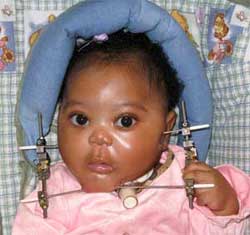What is Neonatal Jaw (Mandibular) Distraction?
 Neonatal jaw (mandibular) distraction is used to treat tongue-based obstructive sleep apnea for infants with a small jaw (micrognathia). The goal of distraction is to increase the size of the lower jaw, moving the oral soft tissues and the tongue forward off the airway. This helps resolve obstructive sleep apnea and potentially avoid tracheostomy.
Neonatal jaw (mandibular) distraction is used to treat tongue-based obstructive sleep apnea for infants with a small jaw (micrognathia). The goal of distraction is to increase the size of the lower jaw, moving the oral soft tissues and the tongue forward off the airway. This helps resolve obstructive sleep apnea and potentially avoid tracheostomy.
Infants are put to sleep for the procedure and then monitored in our Newborn Intensive Care Unit (NICU). They may require narcotics for a few days and then are routinely treated with acetaminophen or ibuprofen.
Before the Procedure
Before the distraction procedure, patients have a polysomnogram (sleep study) and 3D CT scan. Parents or caregivers must follow the routine pre-surgery instructions for the safety of the infant.
During the Procedure
The procedure takes place in the operating room. Your surgeon may elect to place an internal or external distractor. Through two small incisions in the mouth, the doctor makes a cut on each side of the lower jaw (mandible) and places a device on either side of the face attached to pins. The placement of internal devices requires an incision on both sides of the child’s neck by which the jaw is lengthened and the device is placed beneath the skin. Doctors turn the distractor pins using a type of wrench. During surgery, the patient is asleep, and vital signs are monitored closely.
After the Procedure
 Some patients stay in the hospital (in the NICU) during the entire process of distractor turning. By frequent turning of the device (at the hospital or home), the bones gradually separate and new bone is formed in this space.
Some patients stay in the hospital (in the NICU) during the entire process of distractor turning. By frequent turning of the device (at the hospital or home), the bones gradually separate and new bone is formed in this space.
During the distraction process, babies often have a difficult time eating with their mouth. Special feeding techniques are used to keep the infants well nourished.
If patients go home during distraction, parents will learn how to perform incision care, how to turn the distractor arms, and special feeding techniques before leaving the hospital.
Call Your Child's Doctor If:
- There is redness at the incision or distractor arm sites
- You have trouble turning the distraction device



